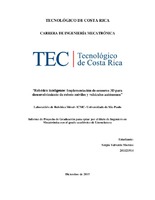Robótica inteligente: Implementación de sensores 3D para desenvolvimiento de robots móviles y vehículos autónomos
Resumen
This project was developed in the Universidade de São Paulo in Brasil, on the
campus located in the city of São Carlos. The work was done specifically in the
Laboratório de Robótica Móvel, which belongs to the Instituto de Ciências Matemáticas e
Computação. As its name indicates, this laboratory does research and develops applications
related to the area of mobile robotics.
The project consisted on developing an application that allows a mobile robot to
navigate autonomously, avoiding obstacles, until it reaches a specific coordinate point
defined by the user. For the design and implementation of this application, it is necessary to
keep in mind that navigation and obstacle detection are based on the use of 3D sensors. For
this purpose, the Kinect was selected.
The simulation and testing of the project was done in a special simulation
environment for robotic applications, called V-REP. The project development process
began with the elaboration of navigation algorithms for obstacle avoidance. Once this goal
was achieved, the potential fields theory was implemented and other sensors were used to
determine the robot‟s spatial position and orientation, with the objective of defining a
trajectory to the goal coordinate point, thus doing a more efficient navigation.
Finally, real data from the physical sensors was used to corroborate the functioning
of the application, with the purpose of comparing it with the previously obtained results
from the simulated part.
Descripción
Proyecto de Graduación (Licenciatura en Ingeniería en Mecatrónica) Instituto Tecnológico de Costa Rica, Área Académica de Ingeniería en Mecatrónica, 2015.


